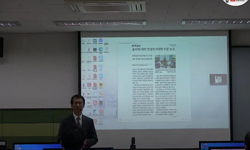Unsteady internal ballistic analysis models of solid and hybrid rocket motors were proposed to study the combustion characteristics of rocket motors. A typical unsteady internal ballistic analysis model was proposed to account for erosive burning with...
http://chineseinput.net/에서 pinyin(병음)방식으로 중국어를 변환할 수 있습니다.
변환된 중국어를 복사하여 사용하시면 됩니다.
- 中文 을 입력하시려면 zhongwen을 입력하시고 space를누르시면됩니다.
- 北京 을 입력하시려면 beijing을 입력하시고 space를 누르시면 됩니다.
하이브리드 및 고체 로켓의 국부 연소 속도를 고려한 내탄도 해석 = Performance Prediction Method of Hybrid and Solid Rocket Motors with Local Variance of Combustion
한글로보기https://www.riss.kr/link?id=T11984888
- 저자
-
발행사항
고양 : 한국항공대학교 대학원, 2010
-
학위논문사항
학위논문(석사) -- 한국항공대학교 대학원 , 항공우주및기계공학과 열 및 유체공학 전공 , 2010. 2
-
발행연도
2010
-
작성언어
한국어
- 주제어
-
발행국(도시)
경기도
-
형태사항
; 26cm
-
일반주기명
지도교수:성홍계
- 소장기관
-
0
상세조회 -
0
다운로드
부가정보
다국어 초록 (Multilingual Abstract)
Unsteady internal ballistic analysis models of solid and hybrid rocket motors were proposed to study the combustion characteristics of rocket motors. A typical unsteady internal ballistic analysis model was proposed to account for erosive burning with the variance of local velocity and pressure along the grain surface of a solid rocket combustor. To validate the model of concern in the study, both cases of non-erosive and erosive burning were compared with previous researches with marginal accuracy. The effects of combustion pressure, grain length, initial temperature, and vaporization temperature of propellants on the erosive burning was investigated. In this study, the biggest factor affecting the erosive burning is the combustion pressure.
The oxidizer mass flow rate of the hybrid rocket motor accounts for the main flow in the chamber because the mass flow rate of the oxidizer accounts for much more than the fuel. The regression rate of the hybrid rocket can also show the function of the oxidizer mass flow rate. Therefore, the oxidizer mass flow rate is an important factor when considering the combustion characteristics of the hybrid rocket. If the rocket doesn't have the pressurization device, the mass flow rate of the oxidizer isn't constant. Liquid N2O without pressurization devices is chosen as the oxidizer supply system. A hybrid rocket engine that can perform the required propulsion impulse is designed with a time-dependent internal ballistic scheme. The experiment data on pressure in the oxidizer tank was used to predict the change of the oxidizer mass flow rate. The analysis results were evaluated and compared with previous experimental data.
An unsteady internal ballistic analysis model was proposed to account for the variance of local velocity and pressure along the grain surface of a hybrid rocket combustor. The model of concern in the study was fairly comparable with the test result. Combustion efficiencies of test results were valued. The local variation of the oxidizer mass flow rate along the grain surface results in changes to the chamber pressure, regression rate, and gas velocity along its flow direction. The difference of pressure is decreased in inverse proportion to the mass flow rate of the oxidizer. But the difference of pressure is increased in direct proportion to the mass flow rate of the oxidizer if the oxidizer mass flow rate reaches a certain level. The result of this study can account for the oscillation of the chamber. An unsteady internal ballistic analysis model to consider the oscillation of the chamber would be proposed in the future.
국문 초록 (Abstract)
고체 로켓과 하이브리드 로켓의 비정상 내탄도 해석 모델을 제안하고 제안한 모델을 이용하여 로켓의 연소특성을 고찰하는 연구를 수행하였다. 고체 로켓의 내탄도 해석을 위해 선행 연구...
고체 로켓과 하이브리드 로켓의 비정상 내탄도 해석 모델을 제안하고 제안한 모델을 이용하여 로켓의 연소특성을 고찰하는 연구를 수행하였다. 고체 로켓의 내탄도 해석을 위해 선행 연구결과를 바탕으로 연소실의 축방향 압력과 속도변화를 고려한 비정상 내탄도 해석모델을 제안하였다. 이를 바탕으로 침식연소를 고려한 내탄도 해석 모델을 제안하였으며 침식연소에 미치는 인자들을 분석하였다. 개발 모델의 검증을 위하여 이미 검증 된 영차원 해석모델의 결과와 본 연구에서 제안한 일차원 모델의 해석 결과를 비교하여 일치함을 확인하였다. 침식연소를 고려한 해석모델의 검증을 위해 선행연구 결과에서 도출 된 축방향 후퇴율 변화를 비교하였으며 해석결과가 일치함을 확인하였다. 침식연소의 원인인 연소실 압력, 그레인 길이, 그레인 초기온도, 추진제 기화온도에 관하여 침식연소에 기여하는 정도를 확인하기 위해 침식연소를 고려하지 않은 일차원 비정상 해석 결과와 침식연소를 고려한 일차원 해석결과를 비교하였다. 비교결과 해석에 이용한 모터 재원의 경우 연소실 요구압력이 침식연소에 가장 큰 영향을 주는 것을 확인하였다.
하이브리드 로켓의 공급 산화제 유량은 후퇴율이 비교적 낮은 하이브리드 로켓의 특성상 로켓 모터의 주 유동이 된다. 또한 하이브리드 로켓 모터 연료의 후퇴율은 산화제 유량에 대한 함수로 나타 낼 수 있다. 그렇기 때문에 하이브리드 로켓에서 산화제의 공급 유량은 로켓 모터의 연소 특성을 결정하는 중요한 요소가 된다. 하이브리드 로켓 모터를 이용하는 과학 로켓의 경우 실제 발사체보다 작은 크기이므로 별도의 가압시스템을 가지지 않는 단순한 구조의 로켓 모터가 선호된다. 그러나 가압 시스템이 없는 경우 산화제의 일정한 공급이 어려우며 이를 고려한 내탄도해석이 필요하다. 본 연구에서는 N2O/PE를 이용한 하이브리드 로켓 모터의 내탄도 해석을 위해 산화제 탱크의 압력 변화를 실험 데이터를 이용하여 탱크 내 압력 변화를 모델링 하여 연소 진행 동안 산화제 유량 변화를 예측하였다. 이를 바탕으로 연소실의 압력 변화 및 로켓의 성능 변수를 도출 하였으며 실제 실험 결과와 비교하였다. 또한 하이브리트 로켓 모터 연소의 축방향 연소 특성 변화를 고찰하기 위해 연소실의 축방향 압력과 속도변화를 고려한 비정상 하이브리드 내탄도 해석모델을 개발하고 이를 바탕으로 산화제 변화에 따른 연소실 압력분포 변화를 해석하였다. 개발 모델 검증을 위하여 연소실 전후단의 압력을 측정한 실험결과와 해석결과를 비교하여 실험과 해석결과가 유사함을 확인하였다. 또한 실험 결과와 해석 결과를 비교하여 산화제 유량에 따른 연소 효율 변화를 평가하였으며 산화제 유량 변화에 따른 연소실 축방향 압력변화와 연소가스의 유속을 고찰하였다. 산화제 유량이 적은 경우 연소실 축방향으로 압력은 감소하며 유량이 증가함에 따라 압력감소 폭은 줄어든다. 그러나 산화제의 유량이 일정량 이상이 되면 연소실 압력은 연소실 후단으로 갈 수 록 증가하게 된다. 이러한 결과는 실제 실험에서 연소실 축방향으로 진동을 발생시킬 것으로 예상되며 압력 역전 시 발생하는 역 유동을 고려한 하이브리드 일차원 모델이 제시되어야 할 것이다.
목차 (Table of Contents)
- 제1장 서론 1
- 1.1. 연구 배경 1
- 1.2. 연구 목적 4
- 제2장 로켓 모터 이론 6
- 2.1. 로켓 모터 성능이론 6
- 제1장 서론 1
- 1.1. 연구 배경 1
- 1.2. 연구 목적 4
- 제2장 로켓 모터 이론 6
- 2.1. 로켓 모터 성능이론 6
- 2.1.1. 로켓 모터 추력 및 성능 변수 6
- 2.1.2. 노즐 유동 이론 8
- 2.2 연소 특성 10
- 2.2.1. 고체 로켓 모터의 연소 특성 11
- 2.2.2. 하이브리드 로켓 모터의 연소 특성 16
- 제3장 고체 로켓의 비정상 내탄도 해석 26
- 3.1. 해석 기법 26
- 3.1.1. 국부 연소 현상을 고려한 해석 기법 26
- 3.1.2. 침식 연소 현상을 고려한 해석 기법 31
- 3.2. 로켓 모터 성능 예측 비교 33
- 3.2.1. 고체 로켓 일차원 해석 기법 검증 33
- 3.2.2. 침식 연소 현상을 고려한 해석 기법 검증 36
- 3.2.3. 연소속도 영향 인자에 따른 해석 결과 비교 38
- 3.2.3.1. 압력의 영향 41
- 3.2.3.2. 그레인 길이의 영향 42
- 3.2.3.3. 온도의 영향 42
- 3.3. 요약 46
- 제4장 하이브리드 로켓 내탄도 해석 기법 47
- 4.1. 해석 기법 47
- 4.1.1. Blow-out공급 방식을 고려한 해석 기법 47
- 4.1.2. 국부연소 현상을 고려한 해석 기법 55
- 4.2 로켓 모터 성능 예측 비교 61
- 4.2.1. 국부연소 현상을 고려한 해석 성능 예측 비교 61
- 4.2.2. Blow-out공급 방식을 고려한 해석 성능 예측 비교 69
- 4.3. 요약 73
- 제5장 결론 및 고찰 74
- 참고문헌 76
- SUMMARY 79












